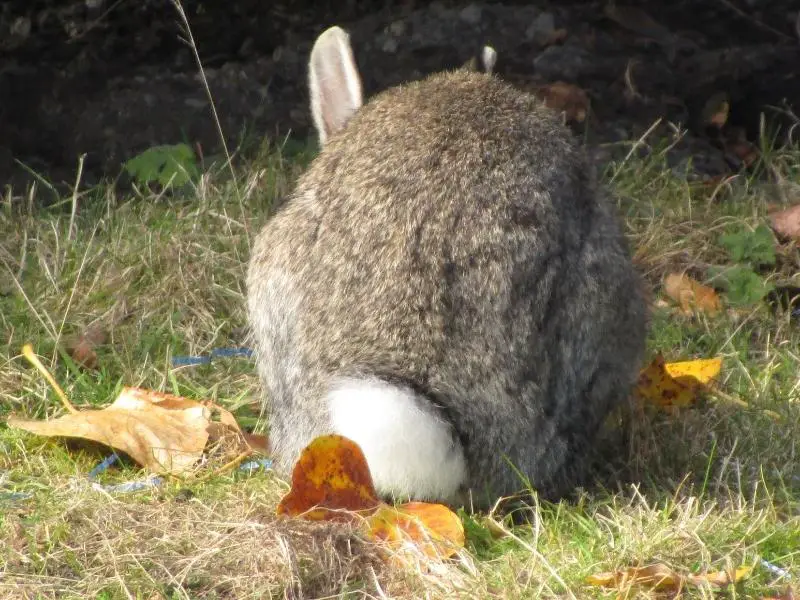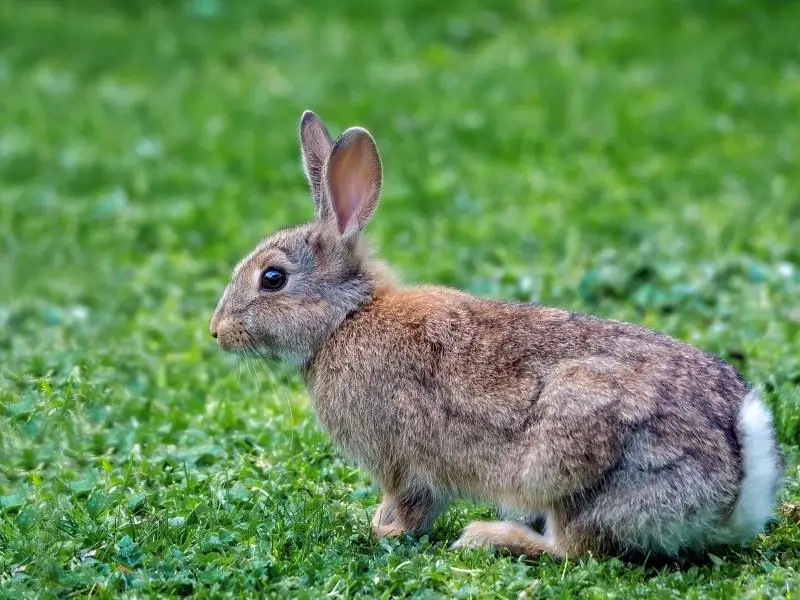Have you ever wondered why bunnies have tails? Not like the Peter Rabbit from Beatrix Potter’s kind of tales. We’re talking about the fluffy, cotton-ball-shaped, cute rabbit tails that make your fluffy friend so adorable.
So do bunnies have long tails?
Rabbit tails vary in size depending on the breed and size of the bunny. The average length of a pet rabbit’s tail is about 2 inches; the longest bun tail recorded (a Continental Giant) is 6.7 inches. A rabbit’s tail is actually longer than it seems since you only see the tip of the tail that sticks out.
The rest of the rabbit’s bushy tail is tucked away underneath layers of fur.
In this guide, you’ll learn everything you need to know about your bun’s furry appendage.
Why Does a Rabbit Have a Tail?
A rabbit’s tail has a significant role to play in its ability to survive in the wild.
The white underside of the tail confuses predators when a rabbit zig-zags away from its pursuer. By flashing its whitetail, a rabbit can signal other rabbits when danger is near.
Because of domestic breeding, your bun may not have a whitetail. This shouldn’t be a concern for you, as your pet bun shouldn’t need to evade predators under your care.
Domestic buns mainly use their short tails to communicate with other rabbits and with their owners.
Mammals such as dogs and cats depend on their long tails for balance. Your fluffy friend has a short tail, which provides stability when making sharp turns and binkying.
What’s the Use of a Rabbit’s Tail?
Besides being absolutely adorable, bunny tails have many interesting uses.
Let’s take a closer look at some of these uses:
A Hasty Escape From Predators
Rabbits are prey animals and need to make a quick escape when they are being hunted down by predators.
They do this by raising their white tails to draw attention to themselves. The rabbit will flick its tail in different directions while zig-zagging away from the predator.
This is known as tail-flagging and causes great confusion for the predator, as it’s unable to predict the direction the bunny will follow. The predator hesitates, and the rabbit uses the opportunity to escape into the warren.
Some predators will reach into a rabbit warren to try and drag the rabbit out. Because of the bun’s short tail, it’s very difficult for the predator to grab onto and drag the rabbit back out.
Signaling and Altruistic Behavior
A rabbit’s tail can be used to send signals to other rabbits in the area. Soundless commands are sent by flicking their tails to warn their family of potential danger.
This amazing and adorable animal will often give away their own position (altruistic behavior) when fleeing from a predator (tail-flagging and thumping). This is to save the family group instead of just itself.
Quick Turns
When your furry friend suddenly changes direction, you’ll notice that its tail moves the opposite way. This balances out the sudden movement and helps them turn quicker.
Body Language and Communication
Paying attention to your fluffy friend’s tail can help you understand them better.
Here are a few ways bunnies use their tails to communicate:
- When they are feeling angry or aggressive, they will lift up their tail as they lunge forward and growl.
- When they are curious or cautious, they will crawl forward on their front paws and leave their back feet and tail outstretched behind them. The tail will face downward as a sign of lack of confidence at that moment.
- Rabbits lift their tails up when they urinate to prevent their fur from getting wet (this is a handy signal for when you are litter training your bun).
- When a rabbit is bored or sexually frustrated, it will chase its tail constantly.
How Long Is a Rabbit’s Tail?

A rabbit’s tail on average is about 2 inches.
The longest rabbit tail measured was 6.7 inches. Your bun keeps its tail close to its body to avoid injury to the sensitive appendage.
When your furry friend is feeling relaxed and safe, it will lie down and extend its tail to its full length.
What Kind of Rabbit Has a Long Tail?
Here is a look at a few rabbit breeds that have longer tails:
European Rabbit
The European rabbit is a small/mini breed of rabbit. They are approximately 15 inches to 20 inches in size from their nose to their tails and weigh approximately 3.5 to 5.5 pounds.
Their tails are fluffy with a length of up to 3 inches. Their fur color is typically gray-brown with a pale belly.
They have a shy, solitary, and skittish temperament and are not really recommended as pets. They are wary of humans but are very social when they are with their own group.
Leporidae Rabbit
These are small to medium-sized rabbits with long legs, feet, and ears. They grow to approximately 10-30 inches and weigh about 13.2 pounds.
The female buns are usually larger than the males. Their tails are bushy and approximately 3.15 inches in length. Their fur is soft with a gray or brown color.
Leporidae rabbits make excellent pets and are cute and cuddly, with lovely temperaments.
The Riverine Rabbit
This is a rare breed of rabbit which has one of the longest tails (between 2.7 and 4.2 inches). A Riverine rabbit can grow up to 18.5 inches long and weighs about 3.96 pounds.
Its fur is gray-brown in color.
This bun has a solitary and nocturnal temperament, and sadly this breed of rabbit is in danger of becoming extinct.
Taking Care of Your Rabbit’s Tail
Rabbit care for your bunny’s tail doesn’t need any special care on your part, as your bun is a meticulous groomer.
If your bun is not overweight or disabled, it’ll keep its own tail clean.
Important rabbit care tips are to remember that most rabbits don’t like their tails played with or touched (there are a few exceptions, of course).
When you groom your bun, take care around the tail area as the skin is very sensitive and you can accidentally rip a rabbit’s tail off without realizing it.
My Last Bunny Thoughts
A rabbit’s tail and the length of the tail are an important part of their survival and anatomy.
A rabbit’s ancestors likely had long tails and were more likely to be caught by predators. Shorter-tailed rabbits had a higher chance of survival, so gradually over the years, the rabbit evolved and their tails became shorter.
Related Articles:

